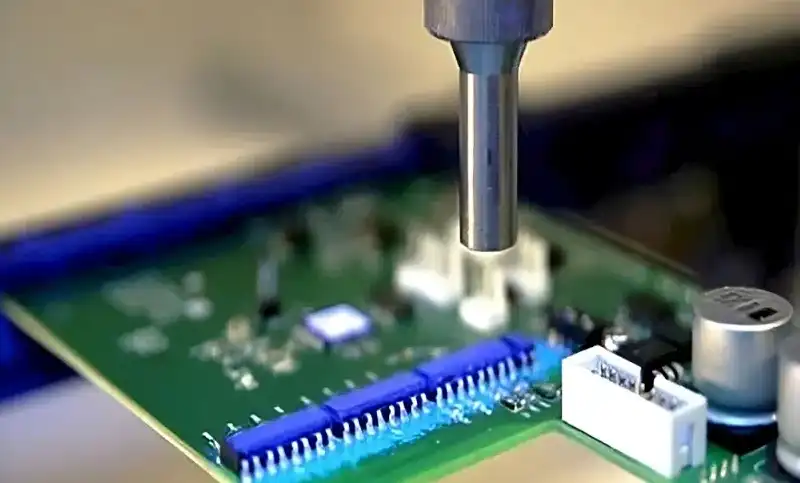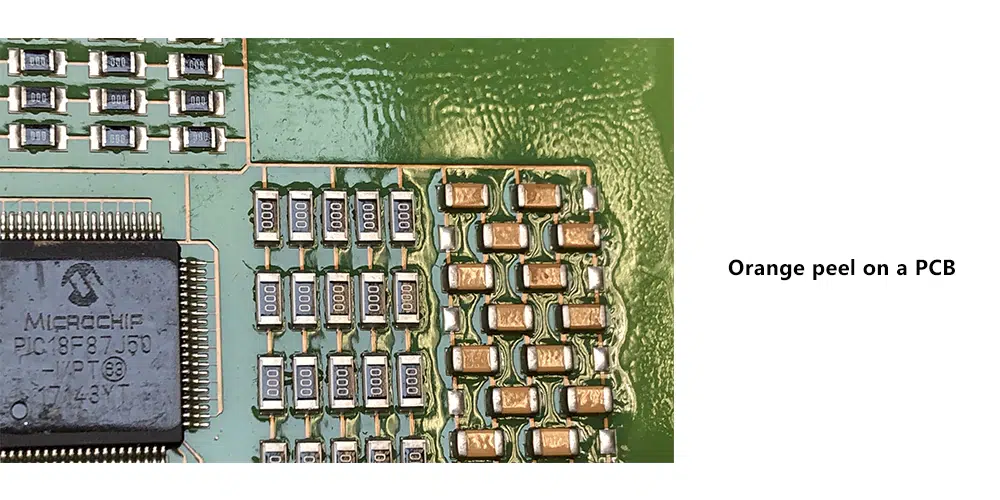
The protective effect of conformal coating makes it more widely used in electronic products. Due to factors such as technology or its own attributes, there still are some faults when we are using the conformal coating. In this article, we will share some common mistakes and solutions during applying conformal coating in PCB.
In the following content, we have summarized six mistakes that are commonly made when we are applying the conformal coating: bubble, white residue, delamination, orange peel, wick effect, and cracks and scratches.
Bubbles refer to the protruding circular bubbles of different sizes that appear after the paint film dries, also called bulges. It can be found between the painted surface and the paint film, or between two layers of paint film. Generally, the diameter greater than 300 microns is called a large bubble, and the diameter less than 300 microns is called a small bubble.
What causes the bubble in the circuit board?
Then, how to fix this situation?
① Defoam or vacuum defoam the glue before using.
② Wipe the PCB board clean before coating to prevent impurities from affecting the adhesion of the glue.
③ When coating, adjust and control the viscosity and fluidity of the glue.
④ Control the spraying pressure and baking temperature of the equipment.
Also read: How to deal with air bubbles in solder joints during PCBA process?

White residue comes from the conformal coating film containing water or other liquids, which makes the film color paler than the original, and appears white mist appears.
What causes white residue on the circuit board?
How to solve this problem?
① It should be dried to control the moisture content of the board before the next process.
② Do not apply the thick coating at one time when coating the conformal paint.
③ To coat in an environment with low humidity (<75%), if necessary, add an appropriate slow-drying solvent.
④ PCBA board surface should be kept clean, dry and free from moisture.
⑤ Do not mix water in the conformal paint and the container.
Also read: How to fix the flux residue from low-temperature solder paste in reflow soldering
In the PCBA production process, PCB conformal painting is the last process. In order to increase the wear resistance, wettability, and beautification of the surface of the PCB board, flux will be used before coating the conformal paint.
If it is not cleaned carefully, there will be chemical residues on the board, which will affect the compatibility of the conformal coating. After a long time, the paint film will slowly separate from the PCB board, resulting in delamination.
How to solve it?
① Clean and dry the circuit board before coating the conformal paint for reducing the film thickness.
② Delamination is caused when the protection is removed, and the adhesion of the paint layer is poor. It is necessary to remove the protection when the coating is dry to the touch (the coating is still soft).

Some automated spraying process leveling is to control the placement time through the speed of the conveyor belt. The diluent evaporates quickly and has a high viscosity, resulting in uneven flow in the unleveled area. Surface unevenness occurs, that is, orange peel.
Higher production environment temperature results in the acceleration of solvent volatilization. Then, the glue is not completely leveled, which will also cause a slight orange peel appearance.
In short, the phenomenon of orange peel after painting the conformal coating is caused by forced curing.
How to cope with it?
① Check the production environment such as temperature and humidity.
② Compare the board cured at room temperature with the board cured by the normal process.
③ Reduce the emission in the leveling volatilization area before curing.
④ Reduce the viscosity of the conformal coating.
⑤ Reduce the slope of the furnace temperature curve.
⑥ Use a thinner that evaporates slowly.
Wick effect of conformal coating is where capillary action pushes material away from certain areas to other areas, with inconsistent results. At best, the resulting conformal coating is sporadic and uneven; at worst, the coating peels off and the substrate is completely exposed.
Capillary flow of conformal coatings is where capillary action pushes material away from certain areas to other areas, with inconsistent results. At best, it might make the coating sporadic and uneven. At worst, the coating peels off and the substrate is completely exposed.
Why wick effect occur?
There are some reasons that caused the wick effect.
How to deal with it?
① Increase the distance between the coating area and the connector.
② Use masking glue around the connector to form a fence.
③ Use a higher-viscosity conformal coating.
④ Reduce film thickness.
⑤ Clean the circuit board.
Cracks are caused by excessive film thickness, and mainly appear in places where the high surface tension such as pins and the edges of components. Scratches come from tooling or mechanical scratches during the coating process.
How to solve it?
① Reduce the film thickness.
② Optimize the furnace temperature curve. And the furnace temperature should not be too high so that the paint film dry and cures slowly.
③ Pay attention to reducing scratches during the process of coating, drying and packaging.
The above are the common mistakes and corresponding solutions for the use of the conformal coating.
Since 2014, Qtech Electronics has been dedicated to providing high-quality one-stop EMS ODM/OEM services. We have a total of 4 manufacturing bases in China, Vietnam and the USA with more than 75,000 square meters. No matter whether small batch production or big batch manufacturing demands, we are capable of meeting your customized requirements.